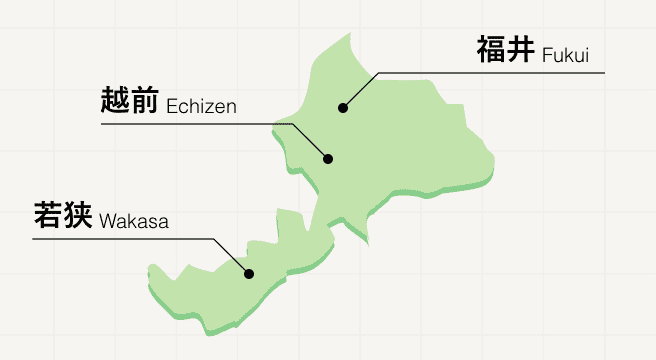Traditional Streets/Houses Spots in Fukui Area
Area
-
-
Fukui
-
-
Fukui

-
-
Traditional Streets/Houses
-
Traditional Streets/Houses
Category


-
- Fukugen Machinami
- Travel / Tourism
- Fukui Fukui-shi Kidonouchicho 28-37
- A castle town streetscape dating back to the warring states period, when the Asakura clan ruled over Echizen. The samurai residences used by the Asakura clan and their chief retainers have been rebuilt. This is included as part of the Ichijodani Asakura Family Historic Ruins site. It has been designated as a National Special Historic Site. The houses were restored based on unearthed cornerstones and foundations and give the idea of what houses were like back in that period. They have been used as shooting locations for various commercials. On the grounds is a spot where you can rent and dress in kimono and you can walk the townscape wearing the kimono.
-
- Teramachi-dori Street
- Travel / Tourism
- Fukui Pref. Onoshi Nishikichou
- "Teramachi Avenue is located near the JR Echizen-Ono Station on the JR Kuzuryu (Etsumi-Hoku) Line in the city of Ono in Fukui Prefecture. Ono is known as the ""little Kyoto"" of the Hokuriku region, and its Teramachi (neighborhood with many temples) was built in the Tensho period (1573-1592) as part of Kanemori Nagachika's establishment of a castle town. He laid out the area in a checkerboard pattern in imitation of the layout of Kyoto and set it up with an emphasis on religion, with temples of every sect located in one small area. Zendoji Temple and Daihoji Temple are two of the most prominent of the many temples, shrines, and samurai houses creating a townscape that evokes pre-modern Japan."
-
- Imajo Shuku
- Travel / Tourism
- Fukui Nanjo-gun Minamiechizencho Imajo
-
- Mikuni Minato Kitamae Street
- Travel / Tourism
- Fukui Sakai-shi Mikunicho Kitahonmachi 4
-
- Mikuni-Minato
- Travel / Tourism
- Fukui Sakai-shi Mikunicho Kitahonmachi
- Located in what is presently Kitahonmachi, Mikuni-cho, Sakai City, this area preserves the historical townscape of the Mikuni Minatomachi port town area that flourished with the Kitamaebune shipping trade routes that crossed the Sea of Japan during the Edo and early Meiji periods. Stroll down the streets lined with shops which sold goods from the ships and townhouses with intricate latticed doors and take in the atmosphere of times past and check out the mini Machi-no-Kura museum and Former Morita Bank Headquarters which is registered as a Tangible Cultural Property of Japan.
-
- Funagoya Boathouse
- Travel / Tourism
- Fukui Mikatakaminakagun-gun Wakasacho Umiyama
- A series of huts in Umiyama, Wakasa Town, Mikatakaminaka County. They were built on the lakeshore of Lake Mikata for agricultural purposes and are used for different occasions such as harvesting plums. Throughout the different seasons you can enjoy the scenery of the traditional grass thatched huts lining the waterside. You can only view the huts from the exterior.
-
- Sancho-machi Town
- Travel / Tourism
- Fukui Obama-shi Katori-Asuka
- A street in Katori, Obama-City. It's located within the Obama-Nishigumi neighborhood, which has been designated as an Important Preservation District for Groups of Traditional Buildings by the Japanese government. The narrow alley, which was formerly a teahouse district, is lined with buildings with red latticed windows and latticed bay windows, and lets you feel what Obama City was like in the days when it was heavily influenced by the culture of Kyoto. On weekends and holidays, you can also visit the traditional Hotoro restaurant, which was built during the Meiji period.
Fukui Areas

Northeast of Kyoto, the ancient Tojinbo Cliffs separate Fukui prefecture from the Sea of Japan in a stretch of land well worth exploring. Water sports and seaside delicacies are available in abundance as the spectacular rugged coastline flattens down into beaches to the west of the prefecture, while inland, Fukui is home to Zen Buddhist temples and historic ruins.
Best of Fukui
Search by Region
-
- Hokkaido / Tohoku
- Hokkaido
- Aomori
- Iwate
- Miyagi
- Akita
- Yamagata
- Fukushima
-
- Kanto
- Ibaraki
- Tochigi
- Gunma
- Saitama
- Chiba
- Tokyo
- Kanagawa
-
- Koshinetsu / Hokuriku
- Niigata
- Toyama
- Ishikawa
- Fukui
- Yamanashi
- Nagano
-
- Tokai
- Gifu
- Shizuoka
- Aichi
- Mie
-
- Kinki
- Shiga
- Kyoto
- Osaka
- Hyogo
- Nara
- Wakayama
-
- Chugoku
- Tottori
- Shimane
- Okayama
- Hiroshima
- Yamaguchi
-
- Shikoku
- Tokushima
- Kagawa
- Ehime
- Kochi
-
- Kyushu / Okinawa
- Fukuoka
- Saga
- Nagasaki
- Kumamoto
- Oita
- Miyazaki
- Kagoshima
- Okinawa


















